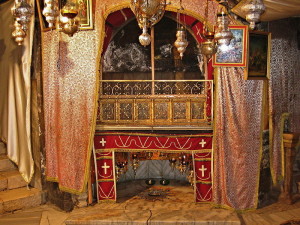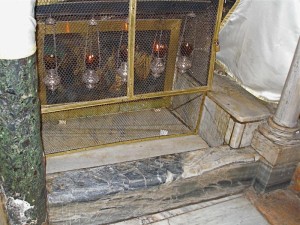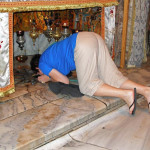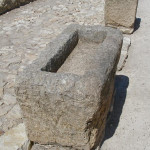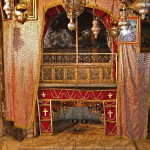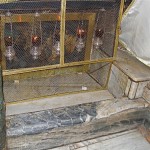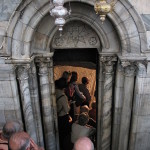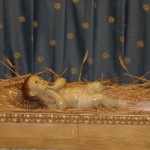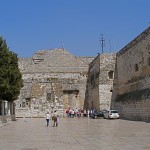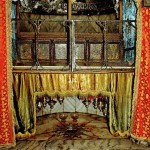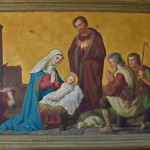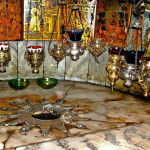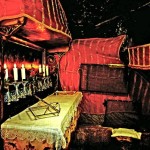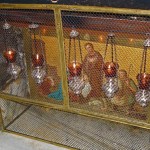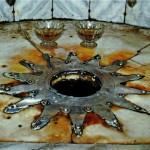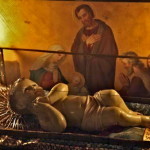West Bank
Far from the Christmas-card image, the place of Christ’s birth is a dimly-lit rock cave. Instead of a star above, a 14-point silver star on the marble floor of the Grotto of the Nativity bears the words “Hic de Virgine Maria Jesus Christus natus est” (Here Jesus Christ was born to the Virgin Mary).
Entry is from Bethlehem’s Church of the Nativity. Steps to the right of the iconostasis (the carved screen standing in front of the main altar) lead down to the subterranean cave.
Rectangular in shape, the cave measures about 12 metres by 3 metres. Like the church above, it is in the possession of the Greek Orthodox Church.
The rough rock of the first Christmas has given way to marble facings and, in the words of biblical scholar E. M. Blaiklock, the cave is “hung and cluttered with all the tinsel of men’s devotions”.
On feast days the cave is lit by 48 hanging lamps. Following a serious fire in 1869, three of the walls are protected by heavy leather drapes backed with asbestos.
Manger covered with marble
At a slightly lower level is the Grotto of the Manger. The rock shelf has been covered with marble, but the original rock may be seen around the manger. The dimensions match those of feeding troughs cut into the rock by Bedouins.
When the original church was built in the 4th century, the Grotto of the Nativity was enlarged to make room for pilgrims and at that time a silver manger was installed.
St Jerome, whose own cave was nearby, did not approve: “If I could only see that manger in which the Lord lay! Now, as if to honour the Christ, we have removed the poor one and placed there a silver one; however, for me the one which was removed is more precious . . . .”
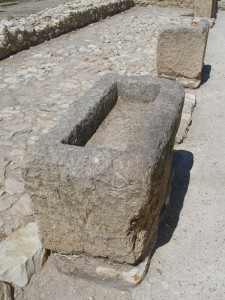
Stone trough from the 9th century before Jesus was born, found at Megiddo (Seetheholyland.net)
A small altar in the Grotto of the Manger is dedicated to the Adoration of the Magi, the Three Wise Men described in Matthew’s Gospel as coming from the East (probably Persia) to worship the newborn Jesus. This is where the Catholics celebrate Mass.
Other sites in the Bethlehem area:
Church of St Catherine of Alexandria
In Scripture:
The birth of Jesus: Luke 2:1-20; Matthew 1:18-25
The visit of the Wise Men: Matthew 2:1-12
Administered by: Greek Orthodox Church
Tel.: 972-2-2742440
Open: April-September, Mon-Sat 6.30am-7.30pm. October-March, Mon-Sat: 5.30am-5pm (5.30pm in January, 6pm February-March). Grotto opens at 11.30am on Sundays.
- Pilgrim venerates star marking Jesus’ birthplace, in Grotto of the Nativity, Bethlehem (Seetheholyland.net)
- Stone trough from the 9th century before Jesus was born, found at Megiddo (Seetheholyland.net)
- Grotto of the Nativity (Darko Tepert)
- Grotto of the Manger (Seetheholyland.net)
- Steps down to the Grotto of the Nativity (James Emery)
- Effigy of Christ child in Grotto of the Nativity (Seetheholyland.net)
- Church of the Nativity (Seetheholyland.net)
- Altar in the Grotto of the Nativity (© Custodia Terrae Sanctae)
- Artwork in Grotto of the Nativity (© Custodia Terrae Sanctae)
- Star marking birthplace of Jesus (Berthold Werner)
- Altar in Grotto of the Manger (© Custodia Terrae Sanctae)
- Lamps hanging over the manger (Seetheholyland.net)
- Close-up of star at birthplace of Jesus (© Custodia Terrae Sanctae)
- Nativity scene in Grotto of the Nativity (© Custodia Terrae Sanctae)
References
Blaiklock, E. M.: Eight Days in Israel (Ark Publishing, 1980)
Brownrigg, Ronald: Come, See the Place: A Pilgrim Guide to the Holy Land (Hodder and Stoughton, 1985)
Freeman-Grenville, G. S. P.: The Holy Land: A Pilgrim’s Guide to Israel, Jordan and the Sinai (Continuum Publishing, 1996)
Gonen, Rivka: Biblical Holy Places: An illustrated guide (Collier Macmillan, 1987)
Inman, Nick, and McDonald, Ferdie (eds): Jerusalem & the Holy Land (Eyewitness Travel Guide, Dorling Kindersley, 2007)
Joseph, Frederick: “Bethlehem”, Holy Land, winter 2002
Murphy-O’Connor, Jerome: The Holy Land: An Oxford Archaeological Guide from Earliest Times to 1700 (Oxford University Press, 2005)
Petrozzi, Maria Teresa: “The Nativity Grotto”, Holy Land, winter 1997
Wareham, Norman, and Gill, Jill: Every Pilgrim’s Guide to the Holy Land (Canterbury Press, 1996)
External links

